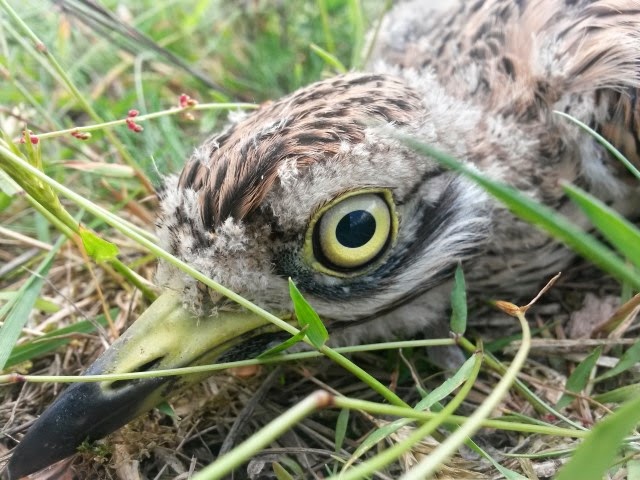It is now the end of the season here at NWT Weeting Heath and unfortunately the end of my summer contract here, I have enjoyed my time here at Weeting Heath and the season has flown by. The dropping temperatures and leaves are the starting signs of autumn and winter, other signs on the reserve are the appearance of several fungi that have been sprouting up at Weeting.
This year has been a good year for the main attraction at Weeting Heath, the stone curlew. Five pairs nested on Weeting Heath this year producing five chicks that fledged from in front of the hides which is the highest for several years.
Three of the fledged chicks came from one pair which managed to have two broods this year. This pair consists of an unringed female and a ringed male which we call Upper Right Black, due to the ring combination including a black ring on its upper right leg (original name I know!). The ringing of stone curlews is part of the Stone Curlew Recovery Project and has been going since the 80s, it gives us an insight and important data into where the stone curlews breed, potential survival rates and where they overwinter from year to year.
%2B(Small).jpg) What makes Upper Right Black interesting is that we have been told potentially this bird was first ringed as a chick in 1990! Making this bird the oldest recorded bird in the project at an age of 23! This bird was part of a pair which successfully reared and fledged three chicks this year. Below is a video I took on my phone earlier in the season showing Upper Right Black with two of its chicks and on the right a close up picture of one of his chicks we ringed this year, lets hope his chick will make it to 23 as well and be back at Weeting Heath in 2037!
What makes Upper Right Black interesting is that we have been told potentially this bird was first ringed as a chick in 1990! Making this bird the oldest recorded bird in the project at an age of 23! This bird was part of a pair which successfully reared and fledged three chicks this year. Below is a video I took on my phone earlier in the season showing Upper Right Black with two of its chicks and on the right a close up picture of one of his chicks we ringed this year, lets hope his chick will make it to 23 as well and be back at Weeting Heath in 2037!Stone curlews normally depart at the end of September or start of October to overwinter in southern Spain or northern Africa such as Morocco (something I know I would like to do). There has been one or two records of stone curlews overwintering in this country when whether conditions are mild enough. So potentially if Upper Right Black has been flying to southern Spain for the last 23 years, it means he has flown roughly a staggering 55,000 miles in its life time, which is twice the circumference of the Earth at the equator!
Other interesting wildlife seen this year include two cranes flying over the reserve in June, which means that 95 species of bird were recorded at Weeting Heath this year. A clouded yellow butterfly was also recorded on the reserve which brought the total number of species for this year to 24. Bats were also recorded for the first time this year at Weeting Heath through the free Norfolk Bat Survey, which anyone can take part in. The results showed that at least eight species of bat use the reserve including brown long-eared, noctule and
Daubenton's.
.jpg)
Spiked speedwell flowered early this year at the end of June rather than July and August due to the warm weather, with over 550 flowering plants counted.
So the season has now ended and the reserve is now all shut until next March, hopefully you will come visit next year where you might get to see old Upper Right Black celebrating his 24th year.
Cheers
%2B(Small).jpg)
